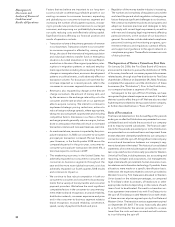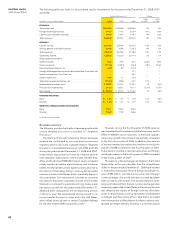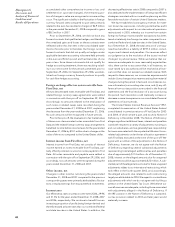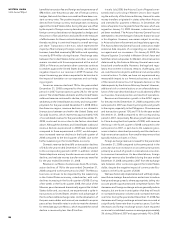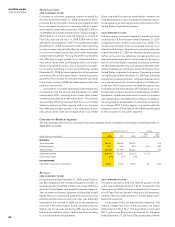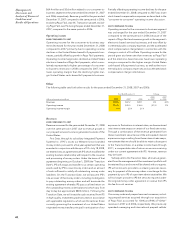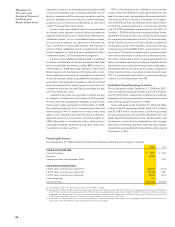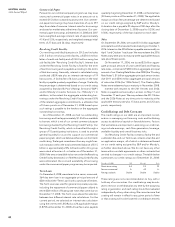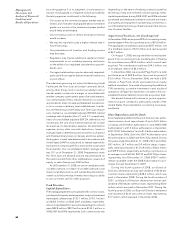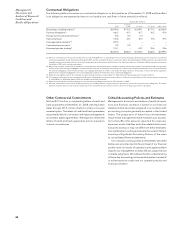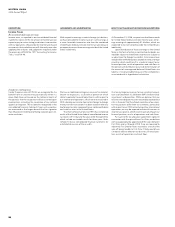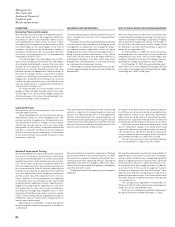Western Union 2008 Annual Report Download - page 29
Download and view the complete annual report
Please find page 29 of the 2008 Western Union annual report below. You can navigate through the pages in the report by either clicking on the pages listed below, or by using the keyword search tool below to find specific information within the annual report.27
Contributing to the increase in total consumer-to-
consumer money transfer revenue and transaction growth
in all periods presented was the growth in transactions at
existing agent locations, the increased number of agent
locations and marketing campaigns promoting the Western
Union brand and services. The majority of transaction
growth is derived from more mature agent locations;
new agent locations typically contribute only marginally
to revenue growth in the first few years of their operation.
Increased productivity, measured by transactions per
location, is often experienced as locations mature. We
believe that new agent locations will help drive growth
by increasing the number of locations available to send
and receive money. We generally refer to locations with
more than 50% of transactions being initiated (versus
paid) as “send locations” and to the balance of locations
as “receive locations.” Send locations are the engine that
drives consumer-to-consumer revenue. They contribute
more transactions per location than receive locations.
However, a wide network of receive locations is necessary
to build each corridor and to help ensure global distribu-
tion and convenience for consumers to generate transac-
tions. The number of send and receive transactions at an
agent location can vary significantly due to such factors as
customer demographics around the location, immigration
patterns, the location’s class of trade, hours of operation,
length of time the location has been offering our services,
regulatory limitations and competition. Each of the more
than 375,000 agent locations in our agent network is
capable of providing one or more of our services; how-
ever, not every location completes a transaction in a given
period. For example, as of December 31, 2008, more than
85% of agent locations in the United States, Canada and
Western Europe (representing at least one of our three
money transfer brands) experienced money transfer activ-
ity in the previous 12 months. In the developing regions
of Asia and other areas where there are primarily receive
locations, approximately 70% of locations experienced
money transfer activity in the previous 12 months. We
periodically review locations to determine whether they
remain enabled to perform money transfer transactions.
2007 COMPARED TO 2006
Consumer-to-consumer money transfer revenue growth
was 9% for the year ended December 31, 2007 over 2006.
This increase was driven by revenue growth of 15% in our
international business on transaction growth of 20%. Our
international consumer-to-consumer business outside of
the United States also continued to experience strong
revenue growth for the year ended December 31, 2007
as a result of strong transaction growth.
Revenue growth in our EMEASA region was 18% on
transaction growth of 26% for the year ended December 31,
2007 over the same period in 2006. The growth in our
EMEASA region during the year ended December 31,
2007, was primarily driven by transaction growth and
the impact of the euro, as further described below.
Contributing to the growth in the EMEASA region was
strong transaction growth of 75% in our money transfer
business to India for the year ended December 31, 2007,
resulting in revenue growth of 44% for the year ended
December 31, 2007.
In addition, fluctuations in the exchange rate between
the euro and the United States dollar have resulted in a
benefit to consumer-to-consumer transaction fee and
foreign exchange revenue of $79 million for the year
ended December 31, 2007 over 2006, that would not have
occurred had there been a constant exchange rate. For
the years ended December 31, 2007, the related benefit
to operating income was $12 million.
Americas revenue declined 2% for the year ended
December 31, 2007 but transactions grew 5% for the
same period. The United States to Mexico, United States
domestic and the United States outbound revenue were
adversely impacted by various factors in the United States
for the year ended December 31, 2007. These factors,
which began in the second quarter 2006, include the
immigration debate and market softness, in part due to
the slowdown in the construction industry. We responded
to these factors by launching distribution, pricing, adver-
tising, promotion and community outreach initiatives.
Within the Americas region, revenue declines in our
domestic business, which represents approximately 11%
of consolidated revenue for the year ended December 31,
2007, continued to occur due to the factors described
above. Domestic revenue declined 10% on transaction
declines of 4% for the year ended December 31, 2007 over
the same period in 2006. Domestic revenue declined at a
higher rate than transactions, due in part to the impact of
price decreases and lower principal amounts sent. In addi-
tion, transactions and revenues for money transfers initi-
ated on our website and through the telephone declined
for the year ended December 31, 2007 compared to the
same period in 2006. Transactions initiated in the United
States were impacted by tightened controls implemented
beginning in early 2007 by Western Union, card issuing
banks and card associations in response to credit and
debit card fraud in the United States. These tightened
controls have directly impacted our consumers’ ability
to use their debit and credit cards to send money on our
website and through the telephone, decreasing the volume
of transactions. Card issuing banks and card associations
have begun to allow more consumer transactions to be
processed, in part in response to Western Union’s own
increased scrutiny of these transactions.
Revenue in our Mexico business, which represented 7%
of consolidated revenue for the year ended December 31,
2007, declined 4% for the year ended December 31, 2007
compared to 2006, despite increased transaction growth
of 4% for the same period due to price reductions taken
in the early part of 2007. However, Mexico revenue and
transaction growth rates began to converge during each
sequential quarter in 2007 as there were no significant
pricing reductions after the early part of 2007.
Revenue and transaction growth in the APAC region
for the year ended December 31, 2007 compared to the
same period in 2006 was driven by strong inbound growth
to the region, especially to the Philippines. China revenue
and transactions grew at 37% and 25% for the year ended
December 31, 2007 compared to the corresponding
period in 2006, respectively.
Foreign exchange revenue increased for the year ended
December 31, 2007 compared to the same period in the
prior year due to an increase in cross-currency transac-
tions primarily as a result of strong growth in international
consumer-to-consumer transactions, partially offset by
reduced foreign exchange rate spreads in selected markets.
27
Management’s
Discussion and
Analysis of Financial
Condition and
Results of Operations


